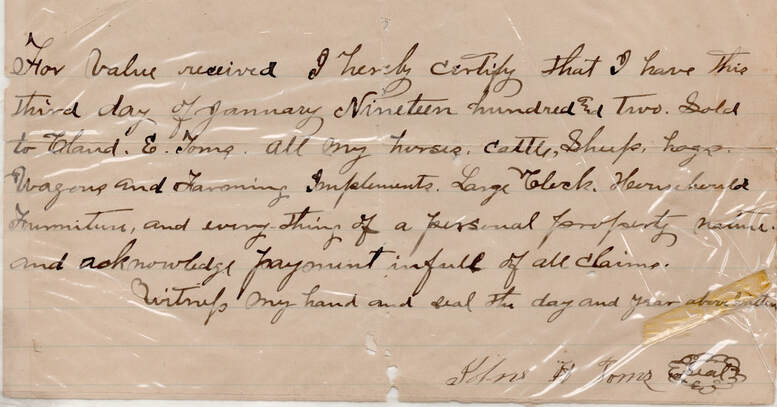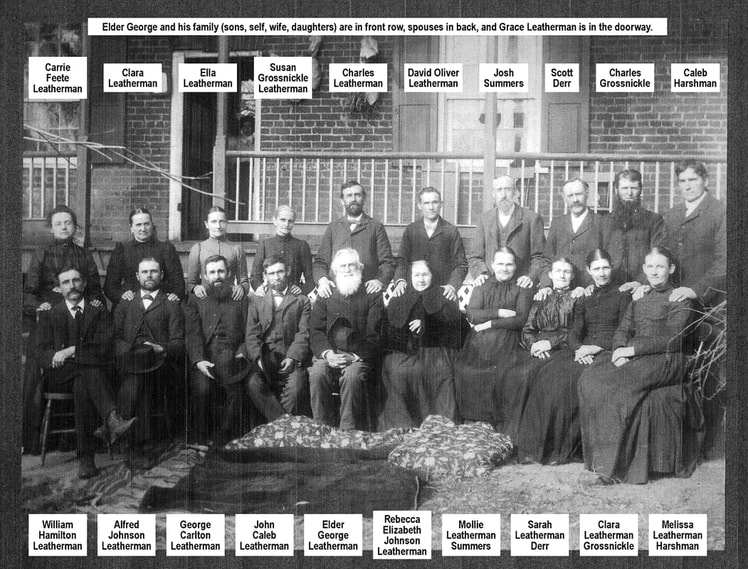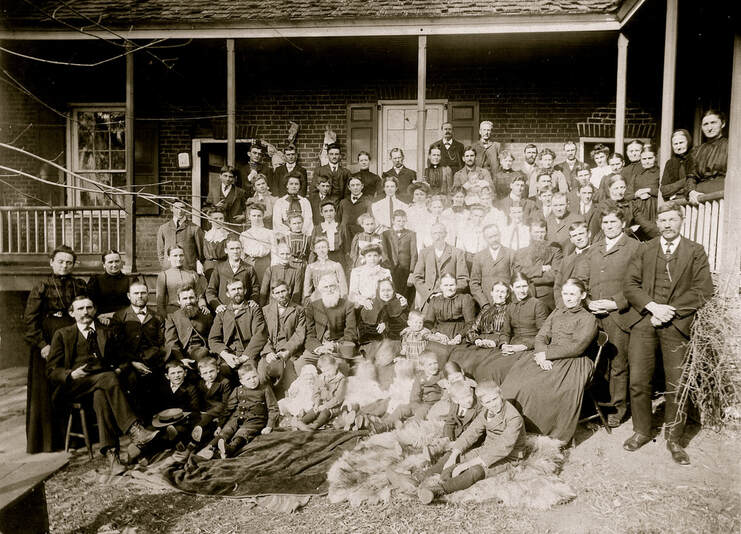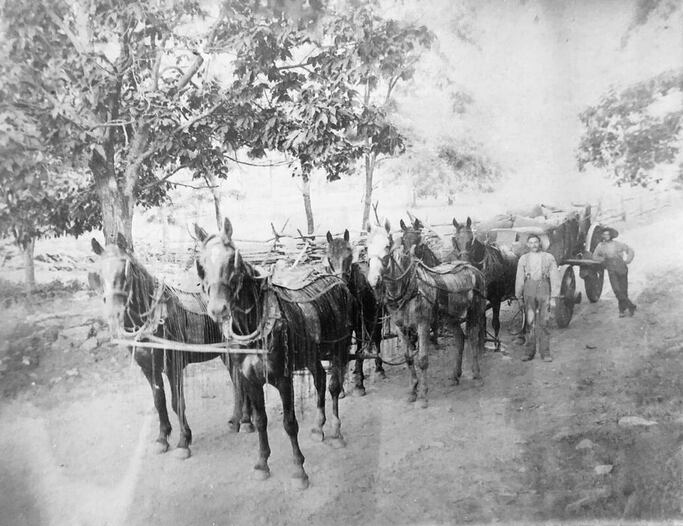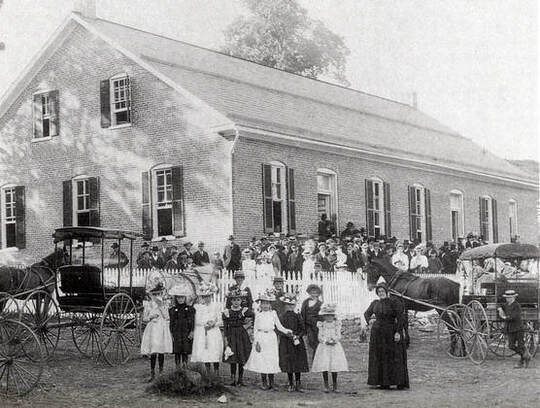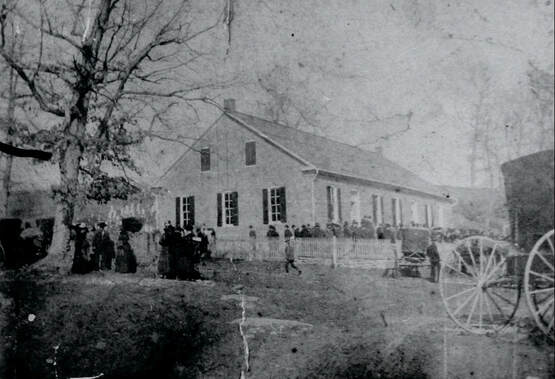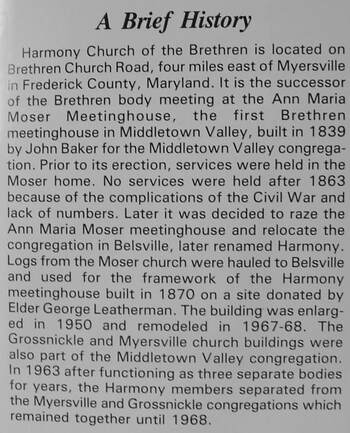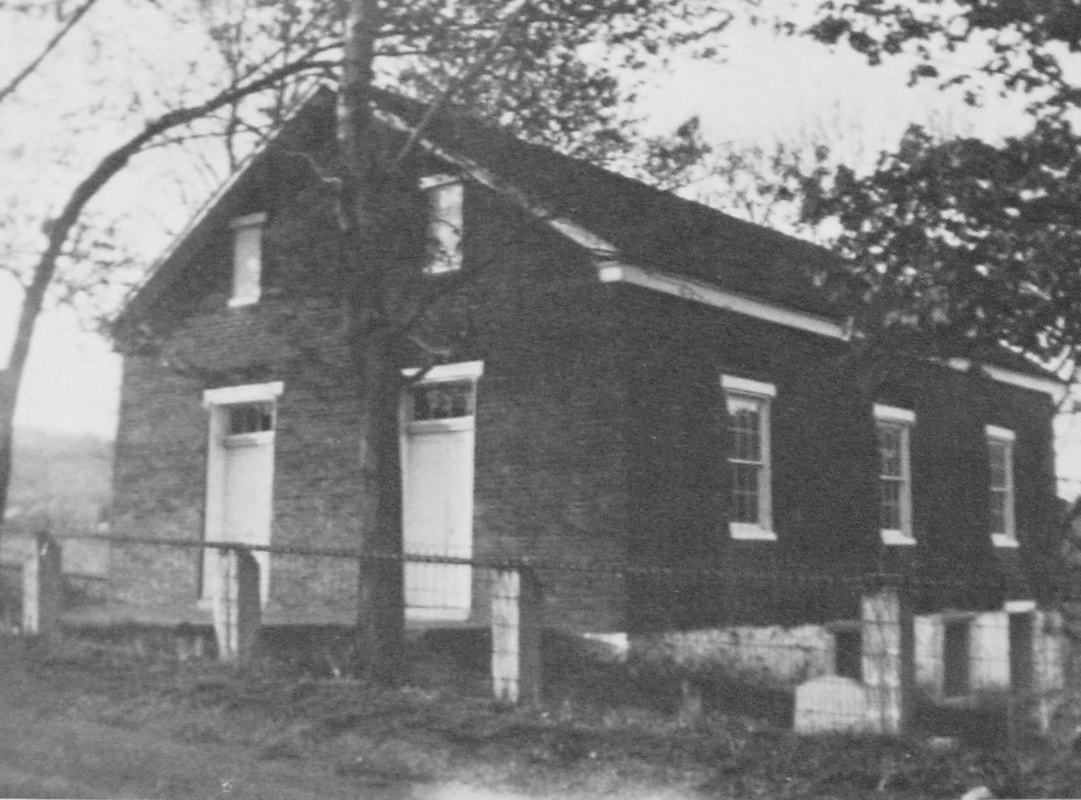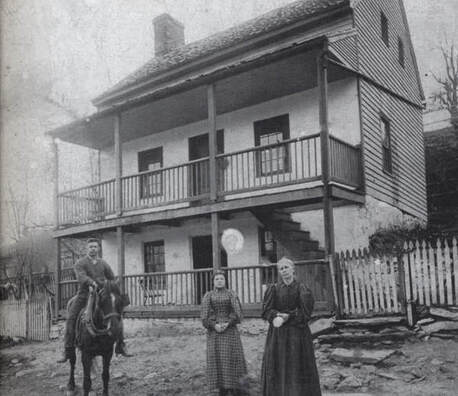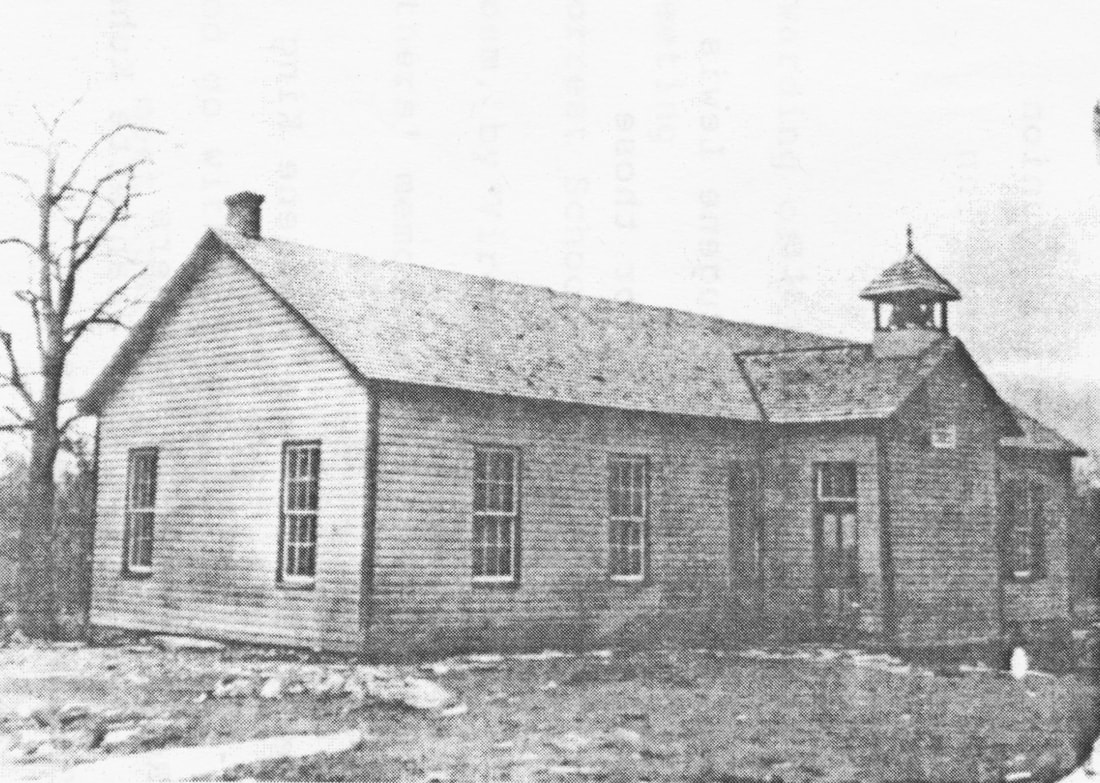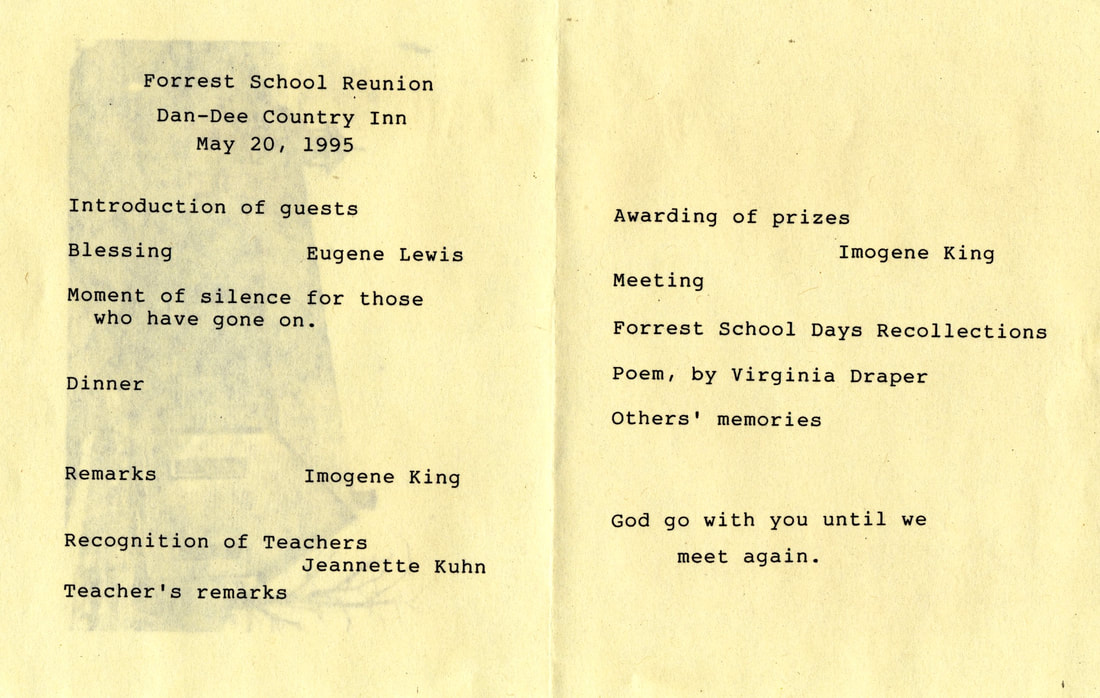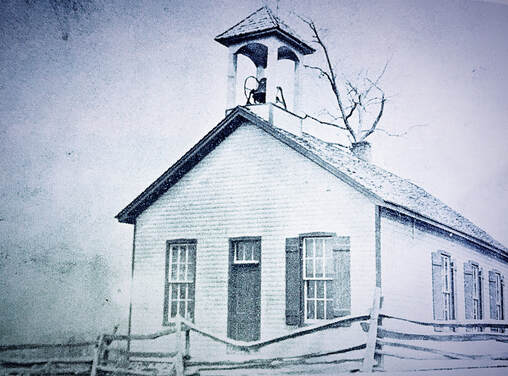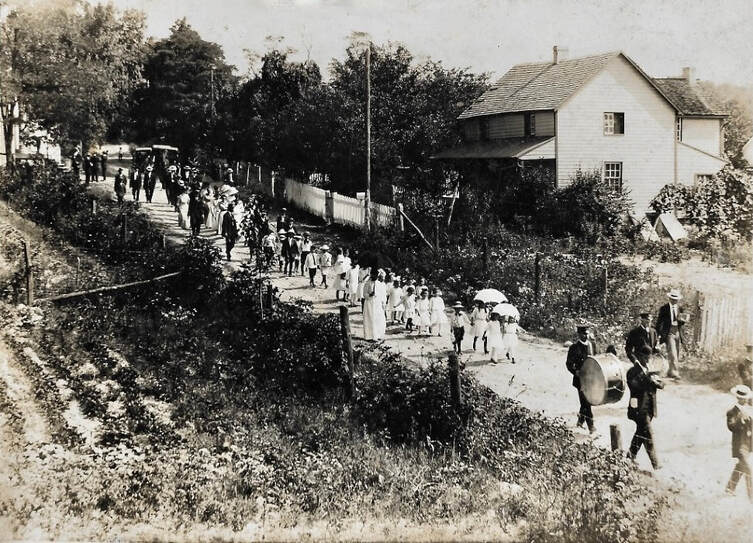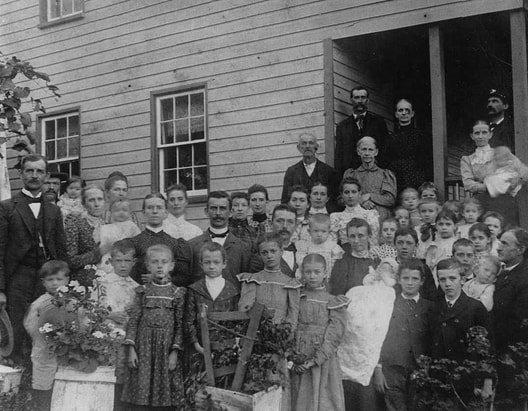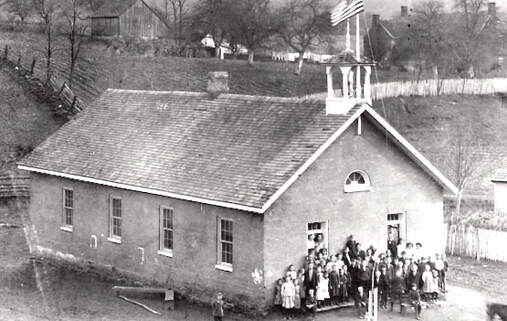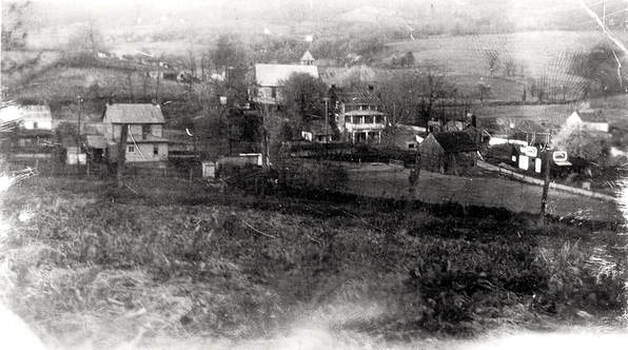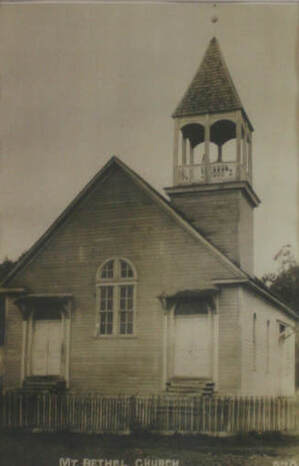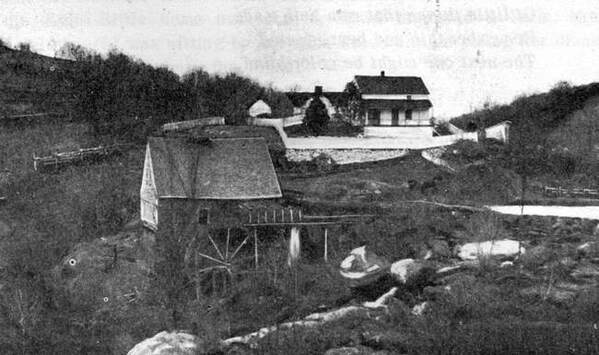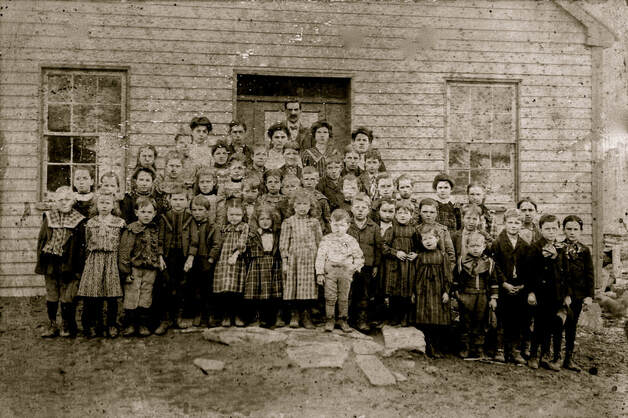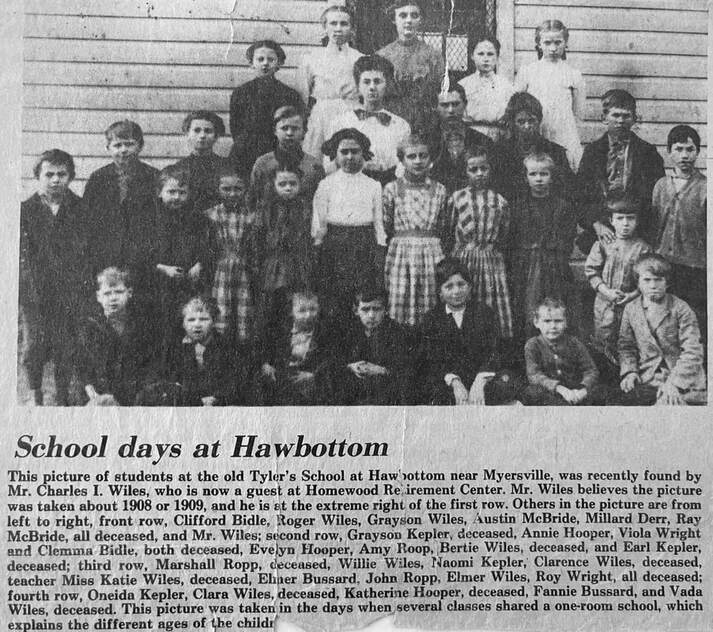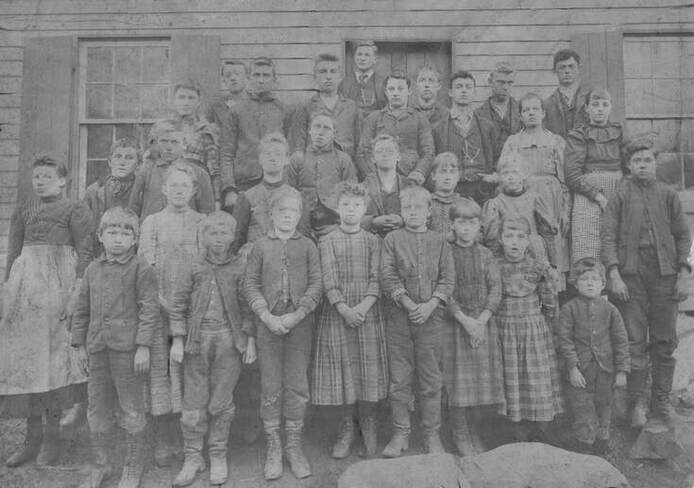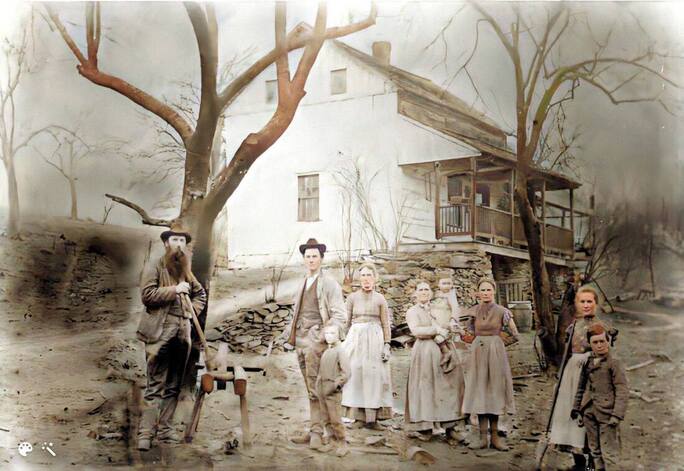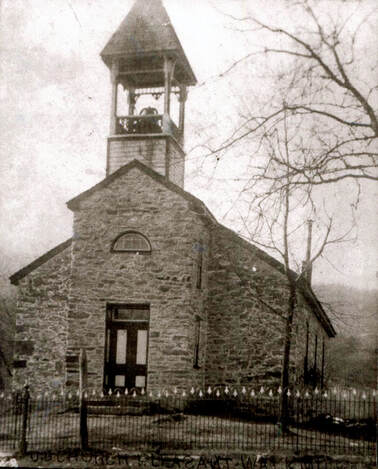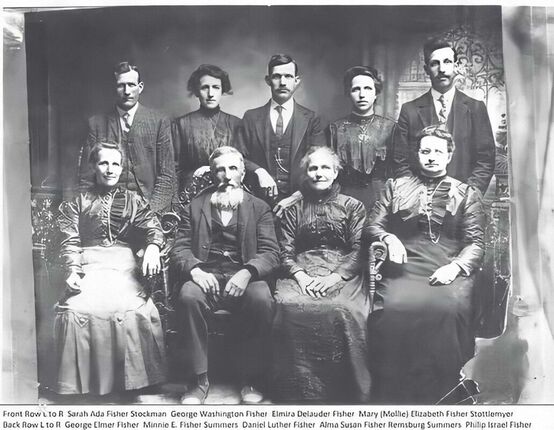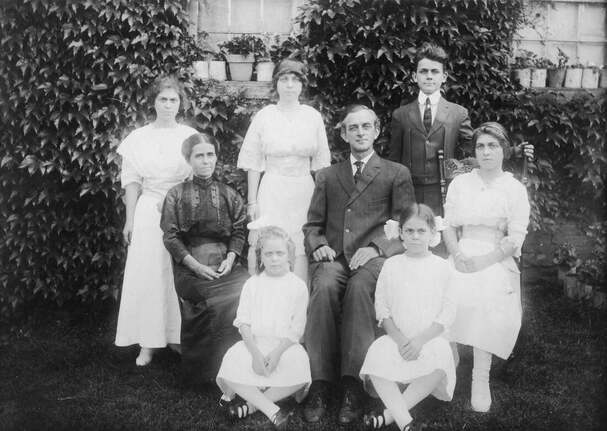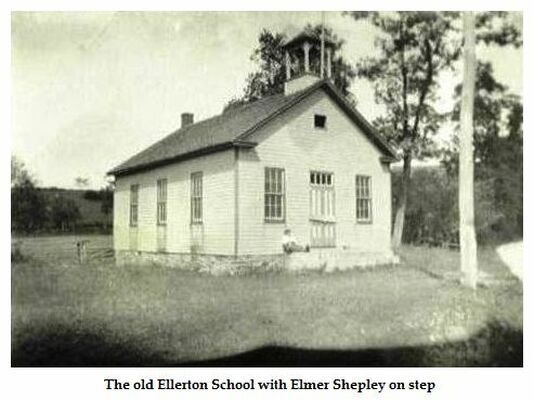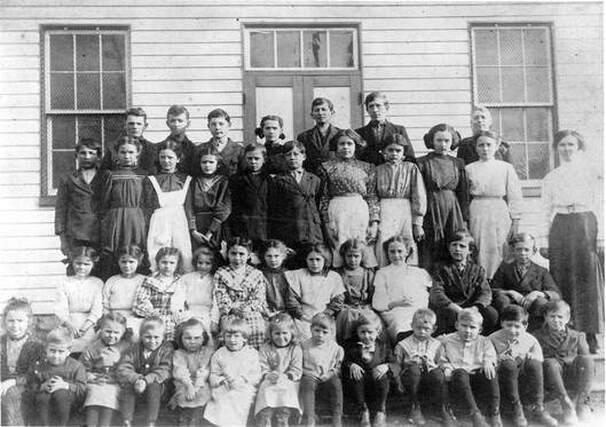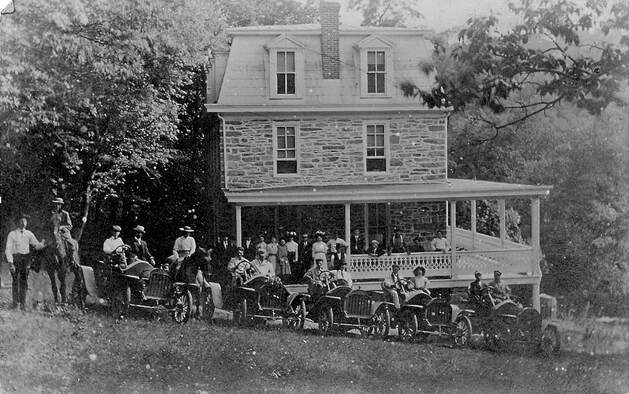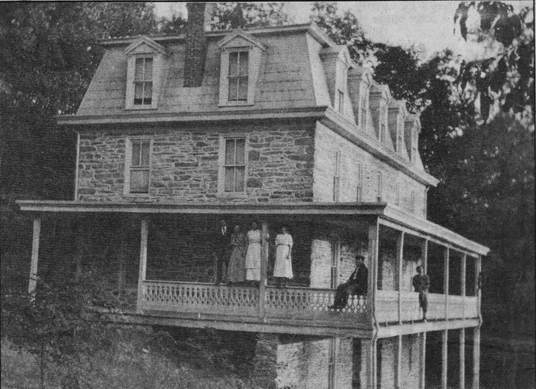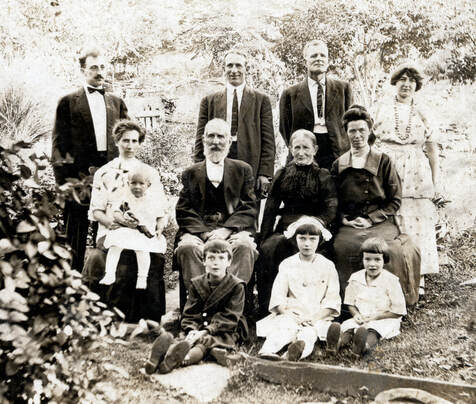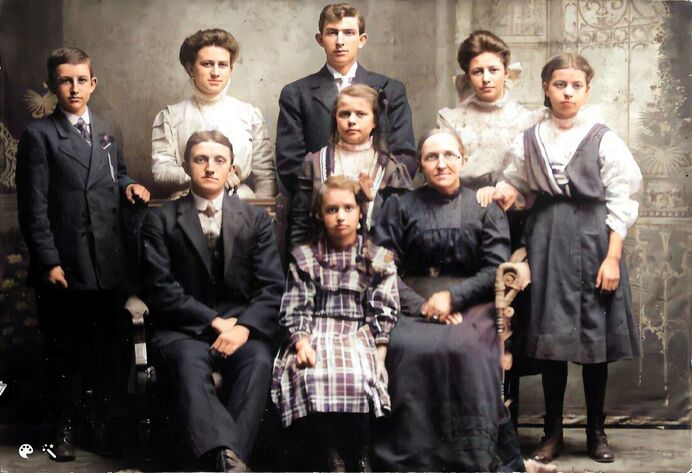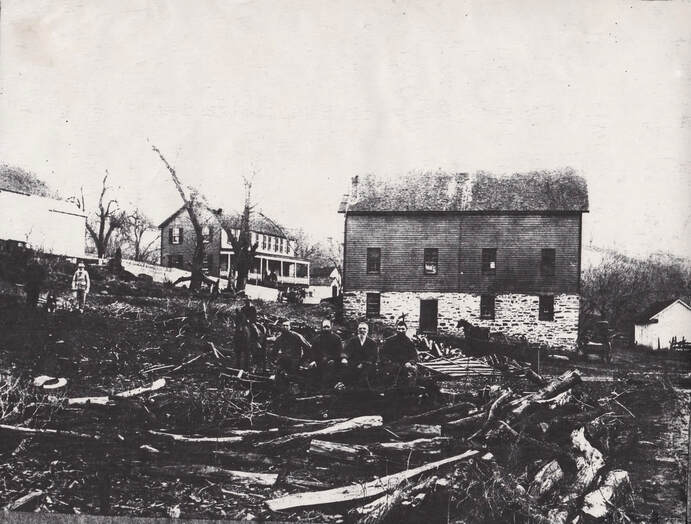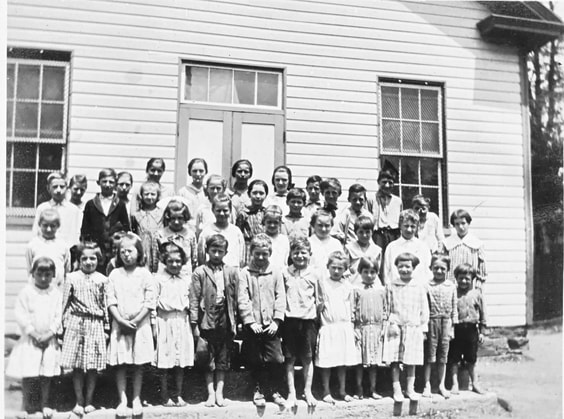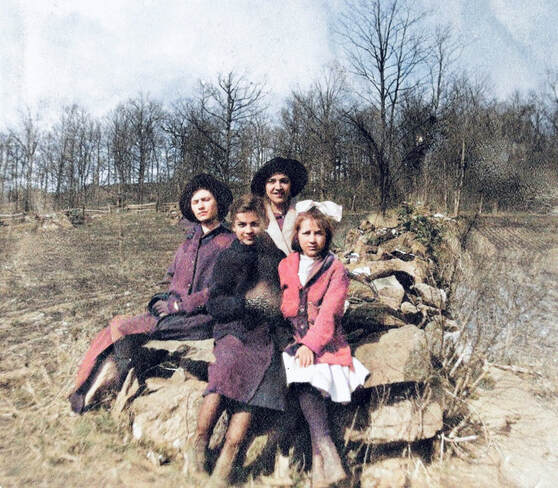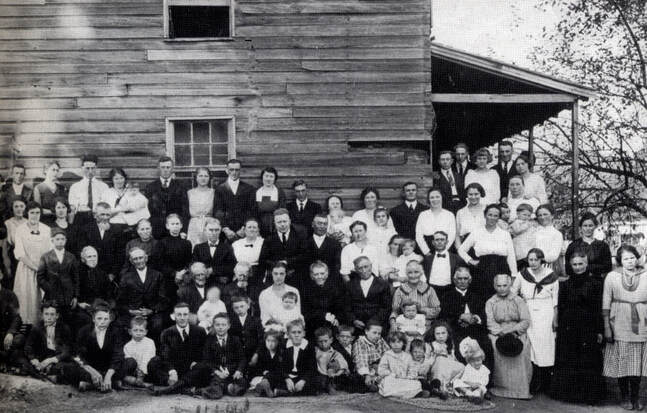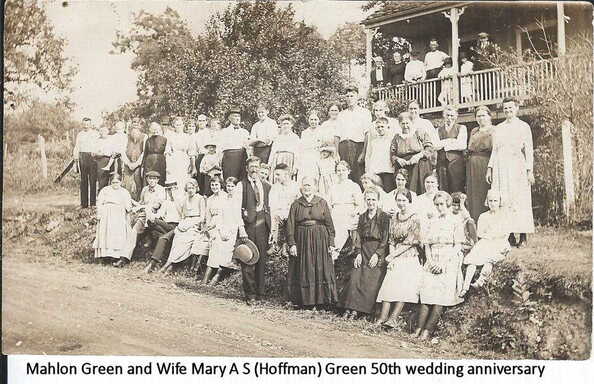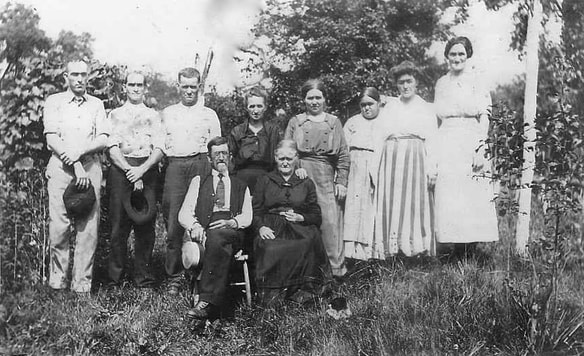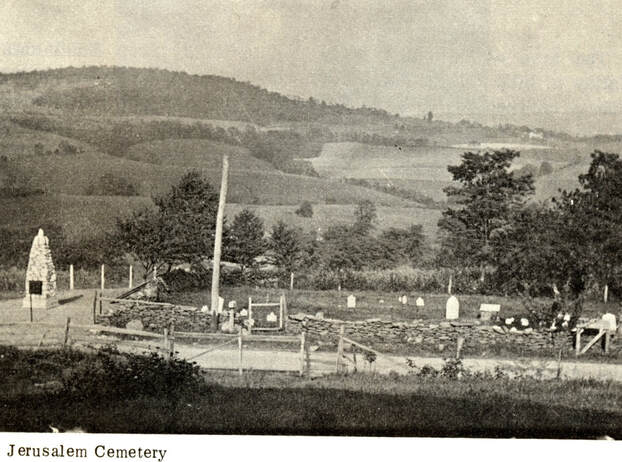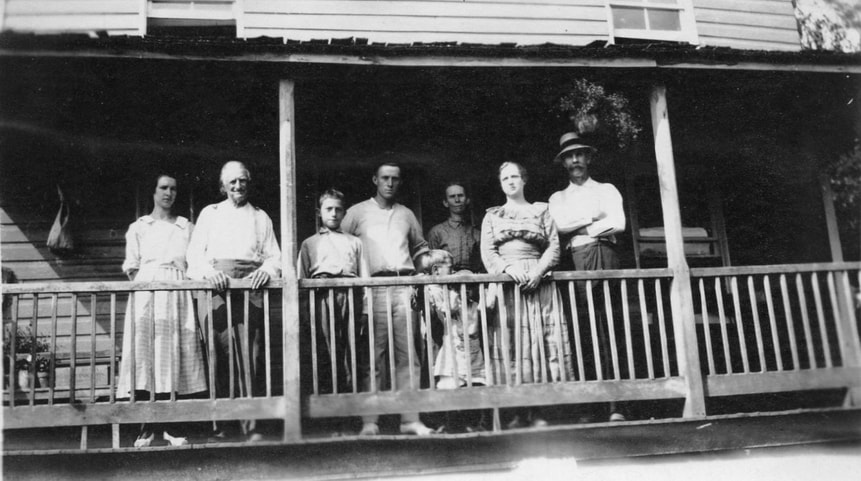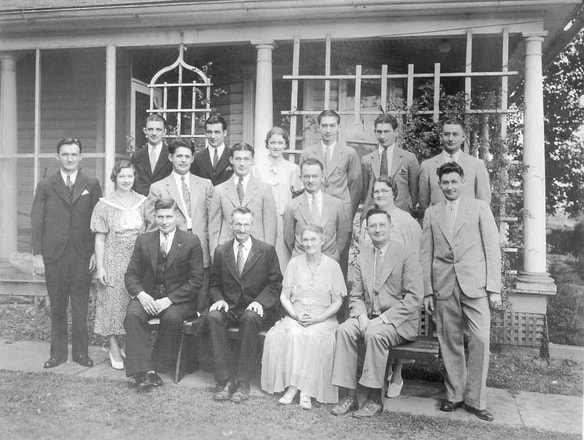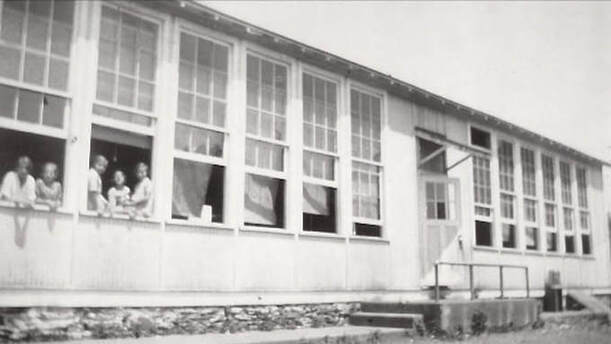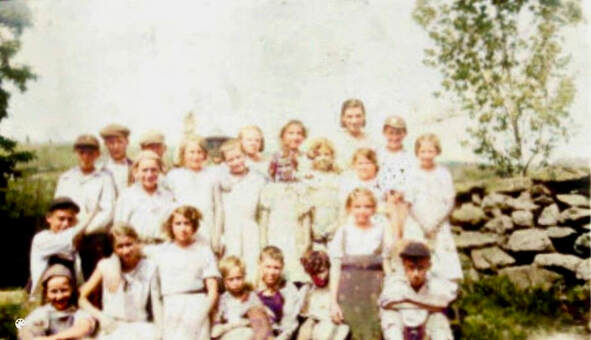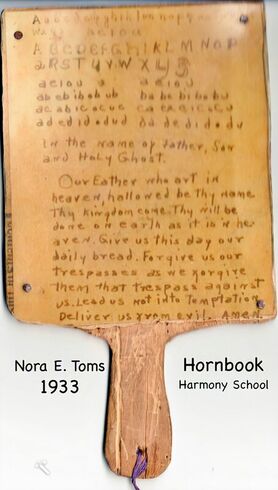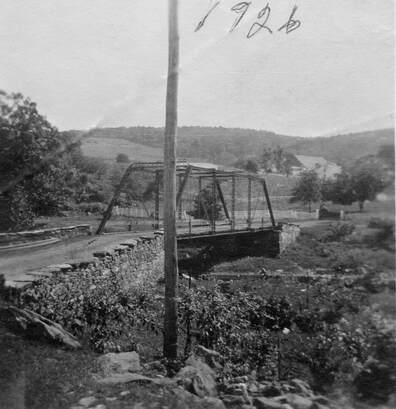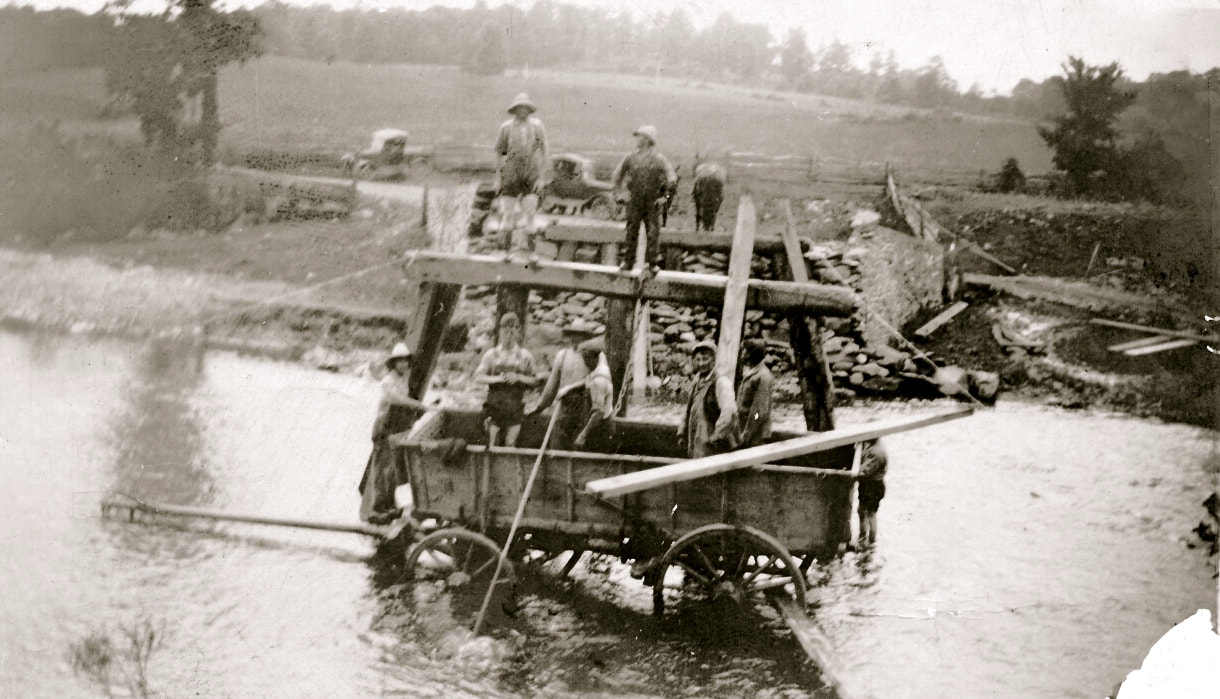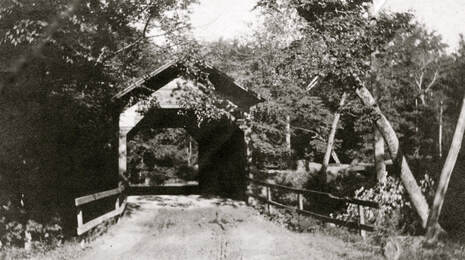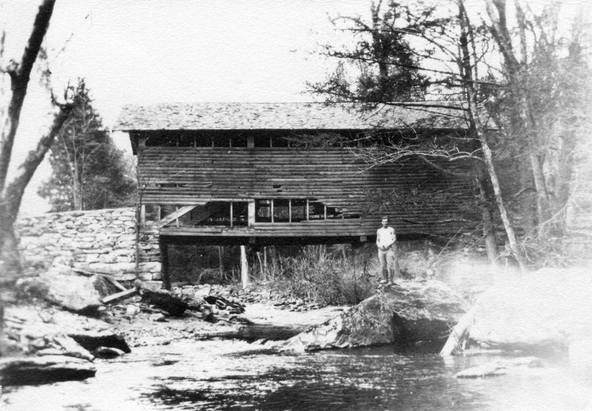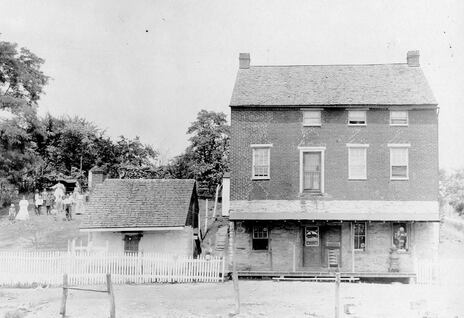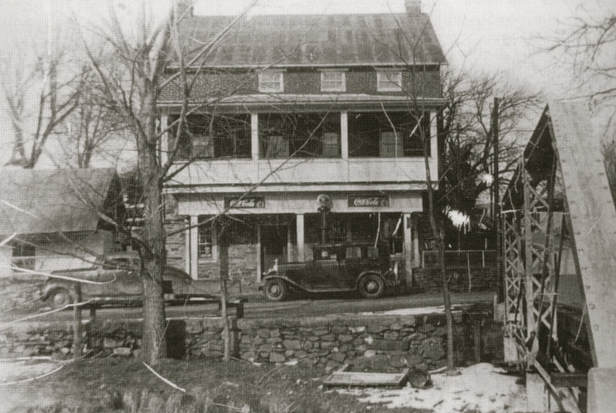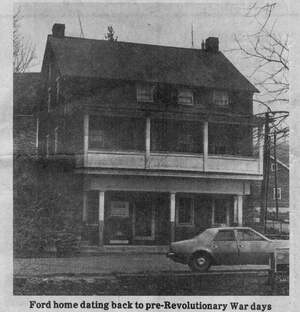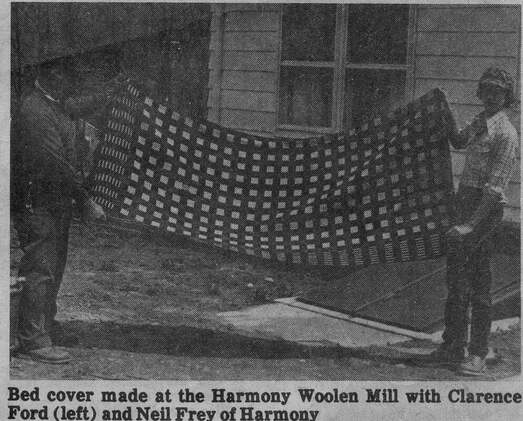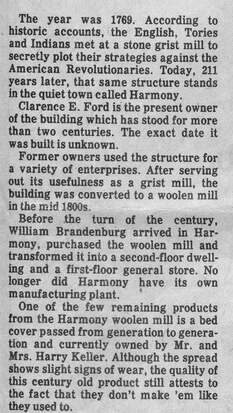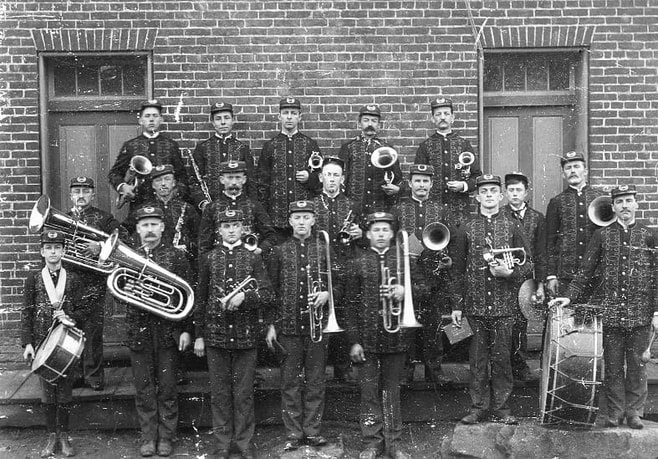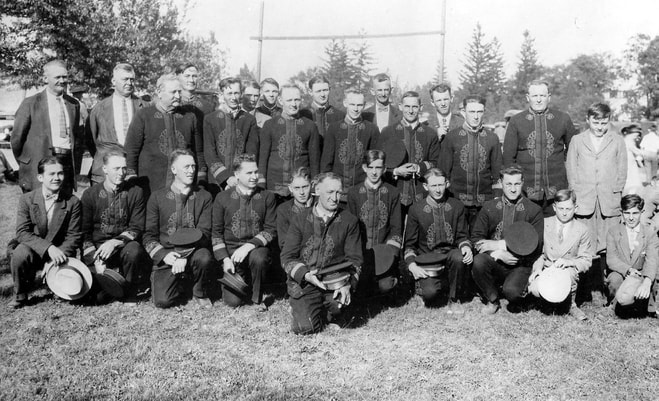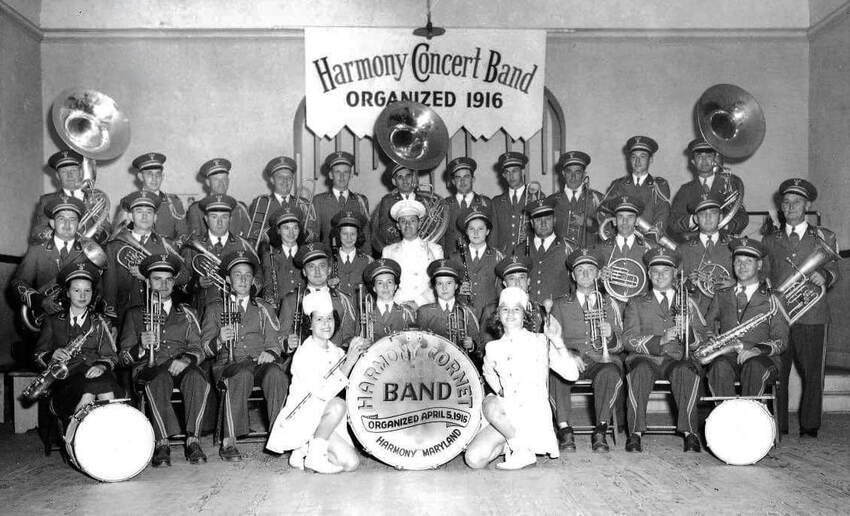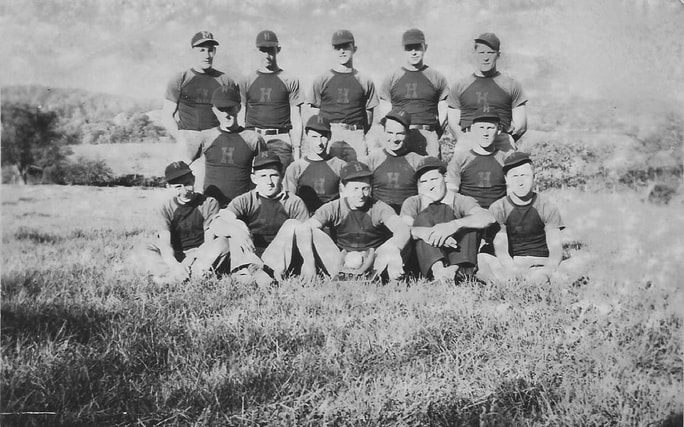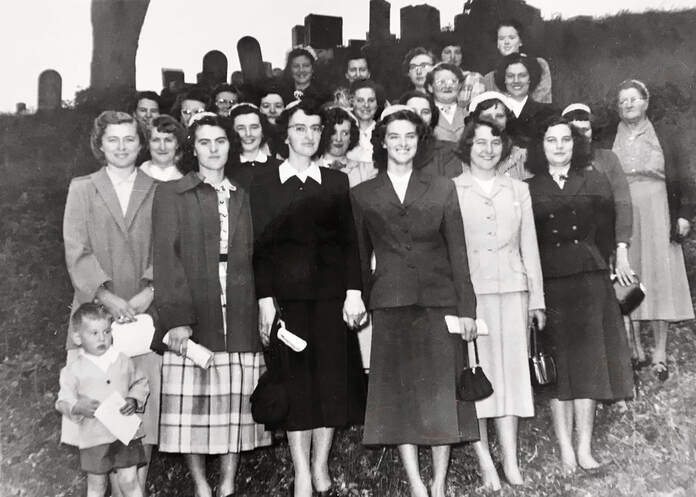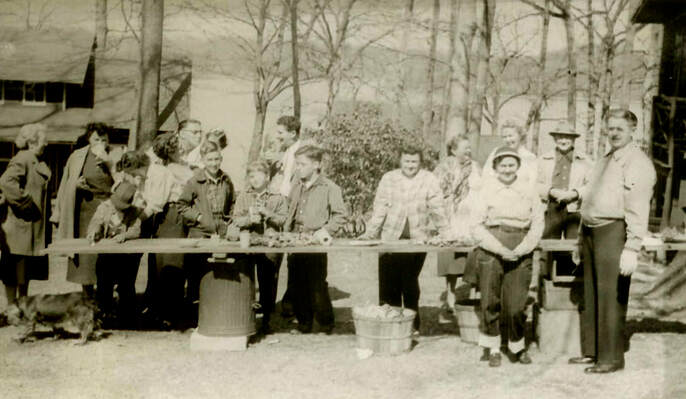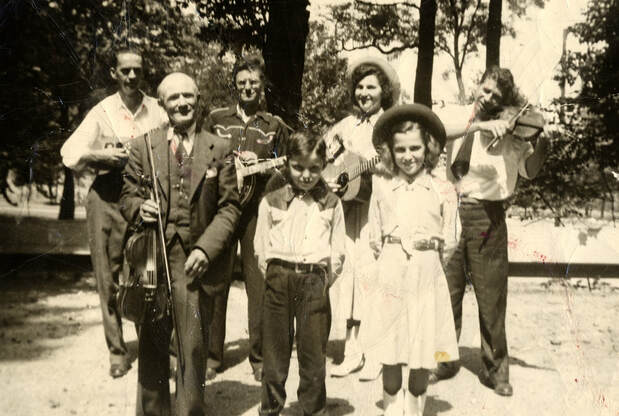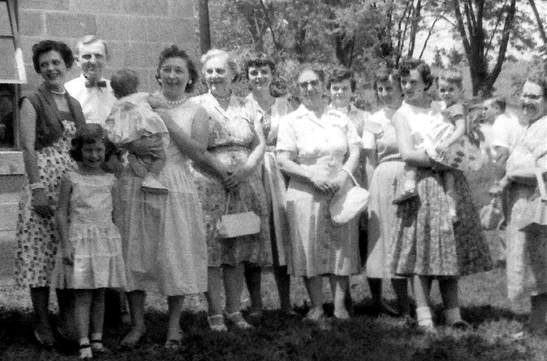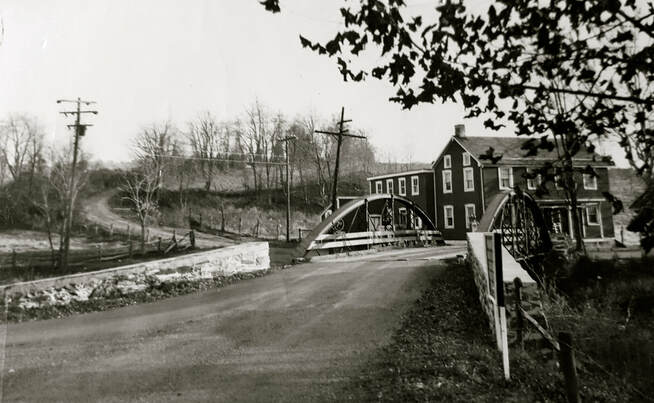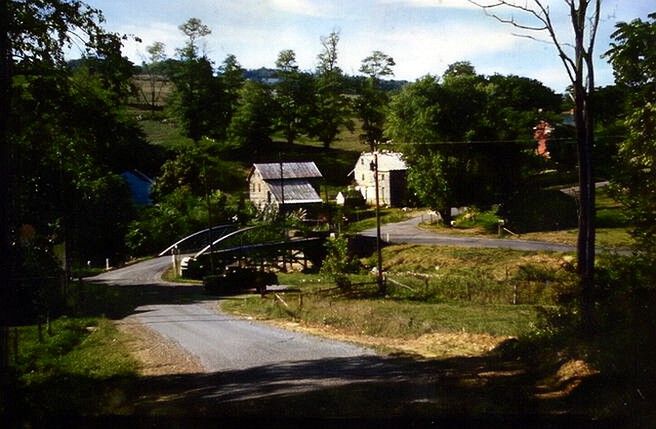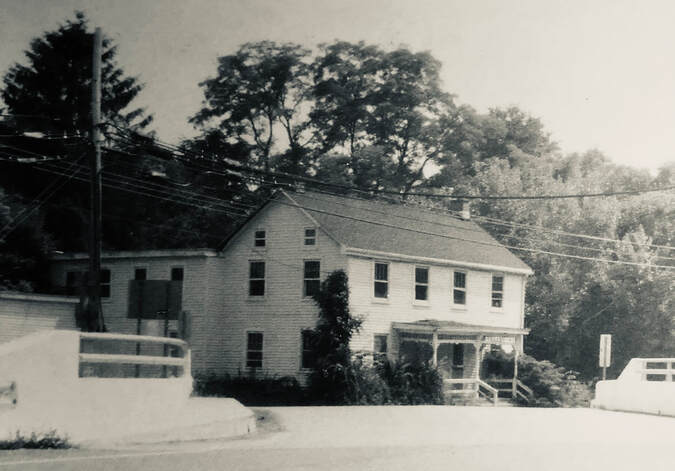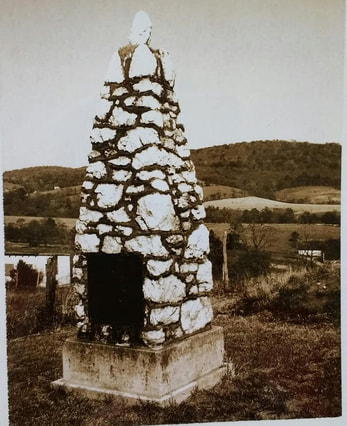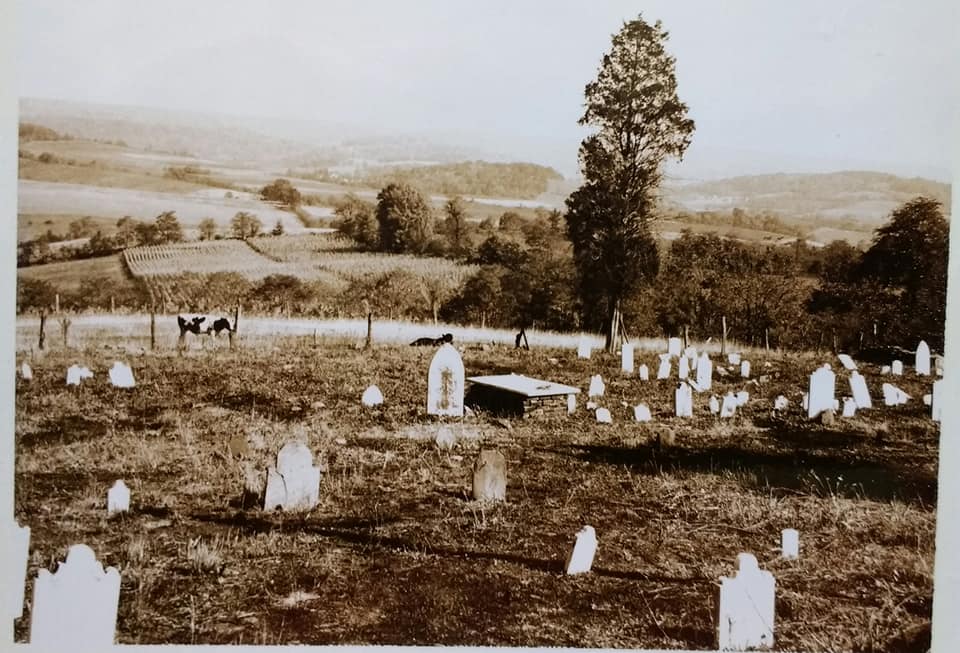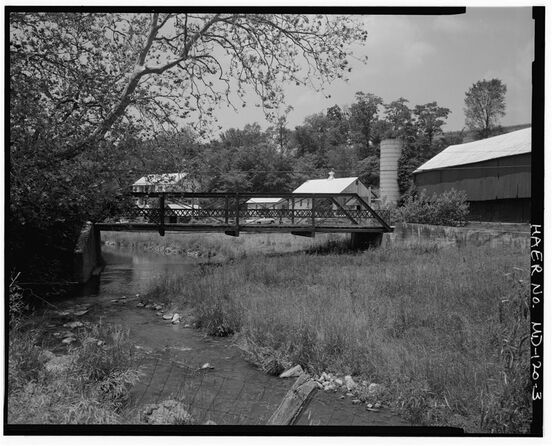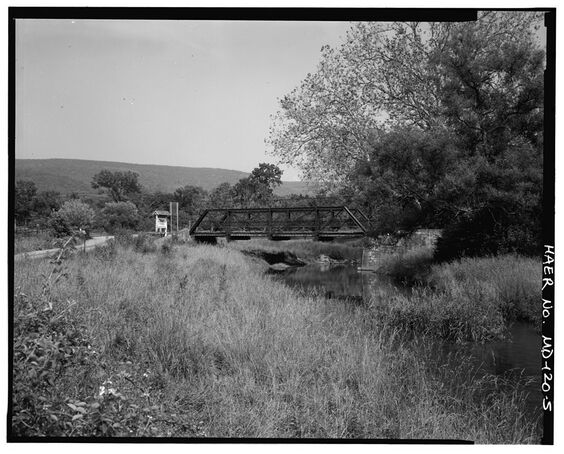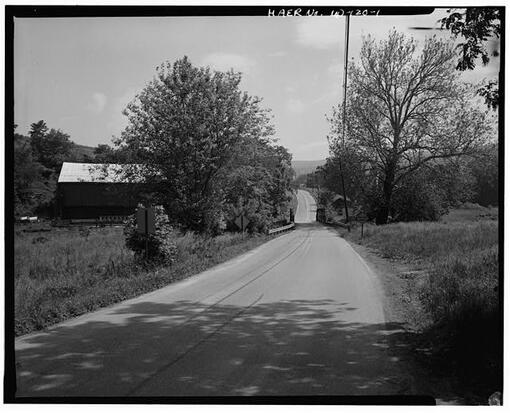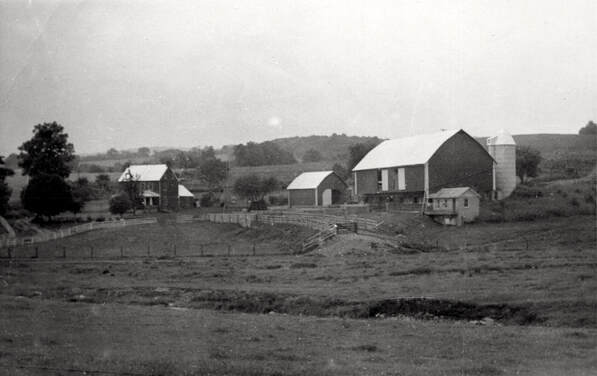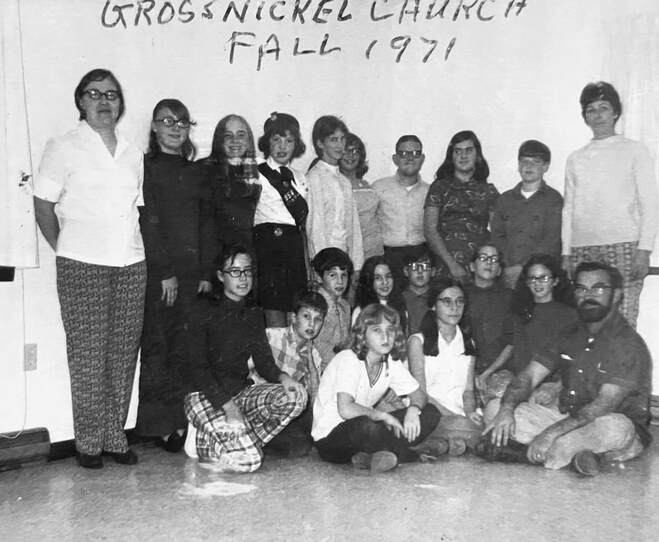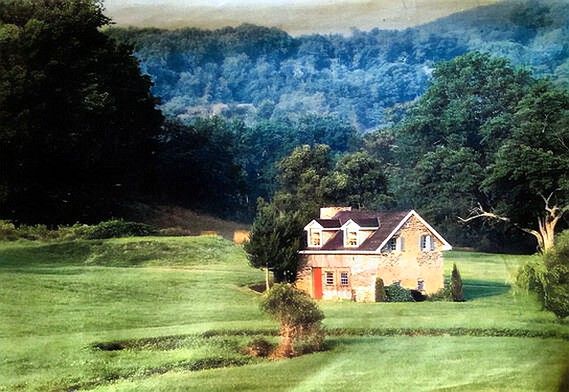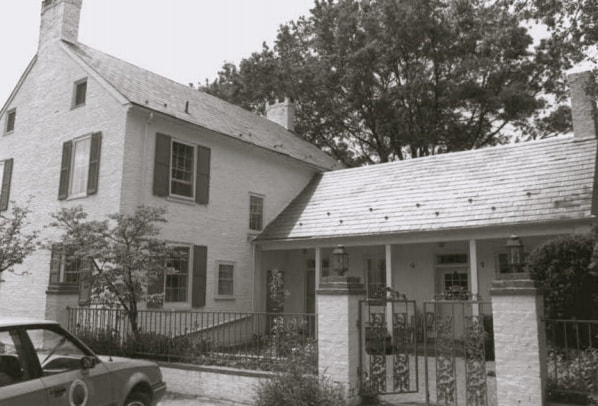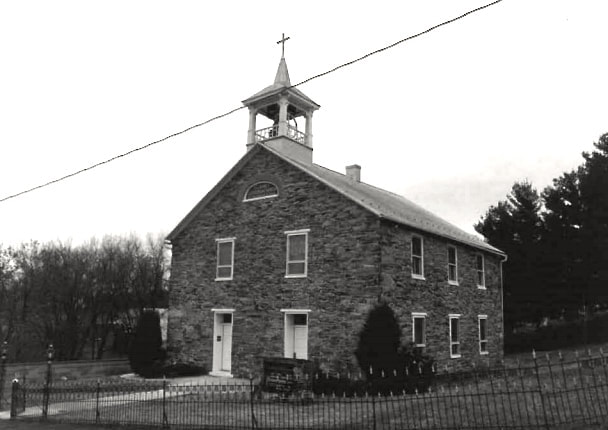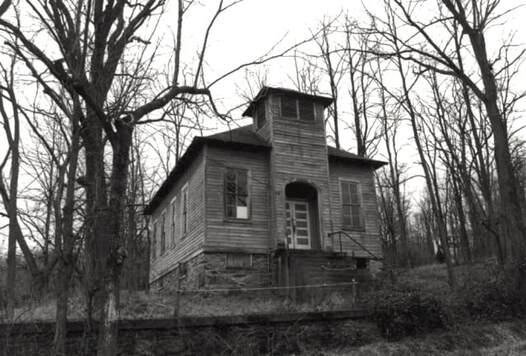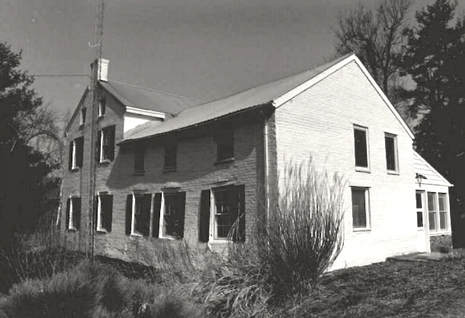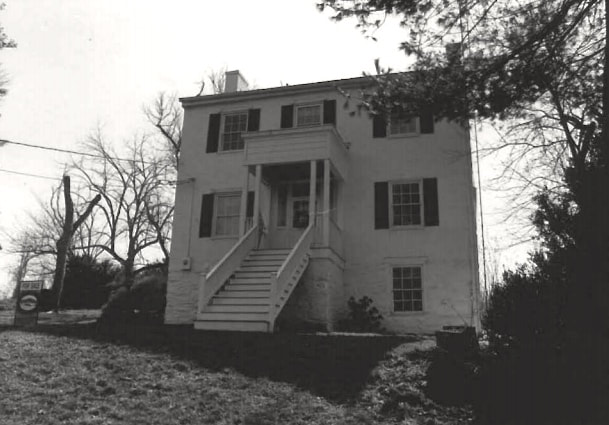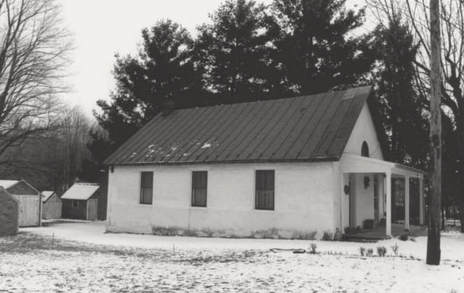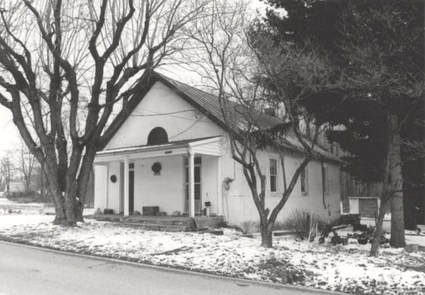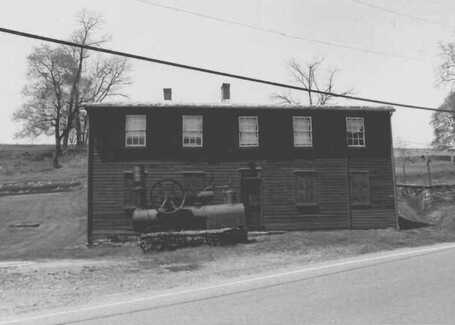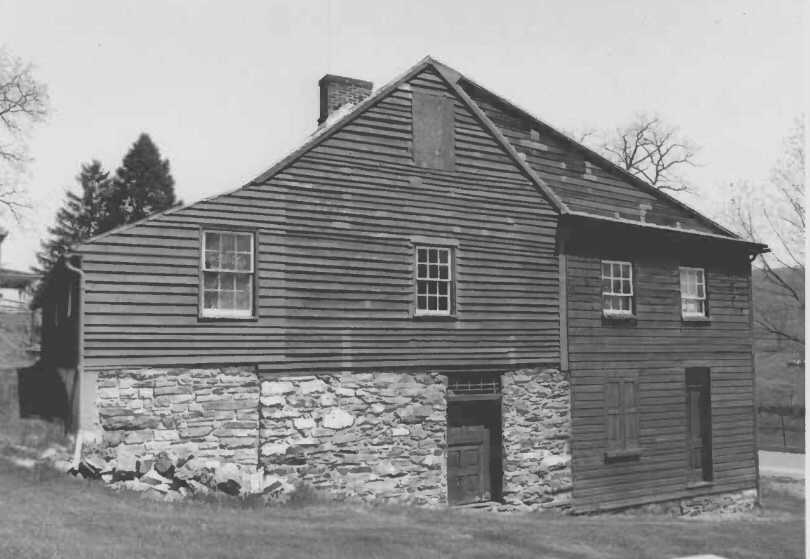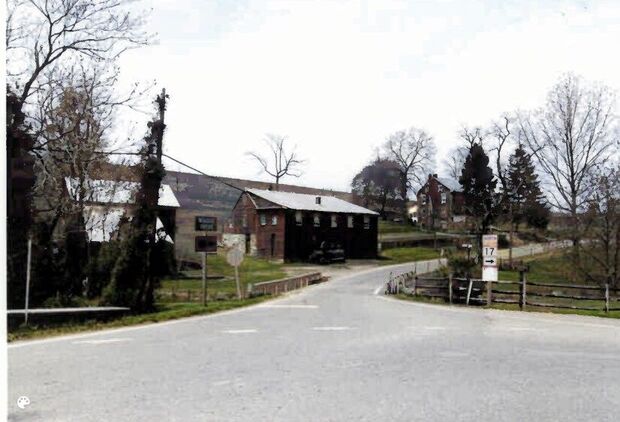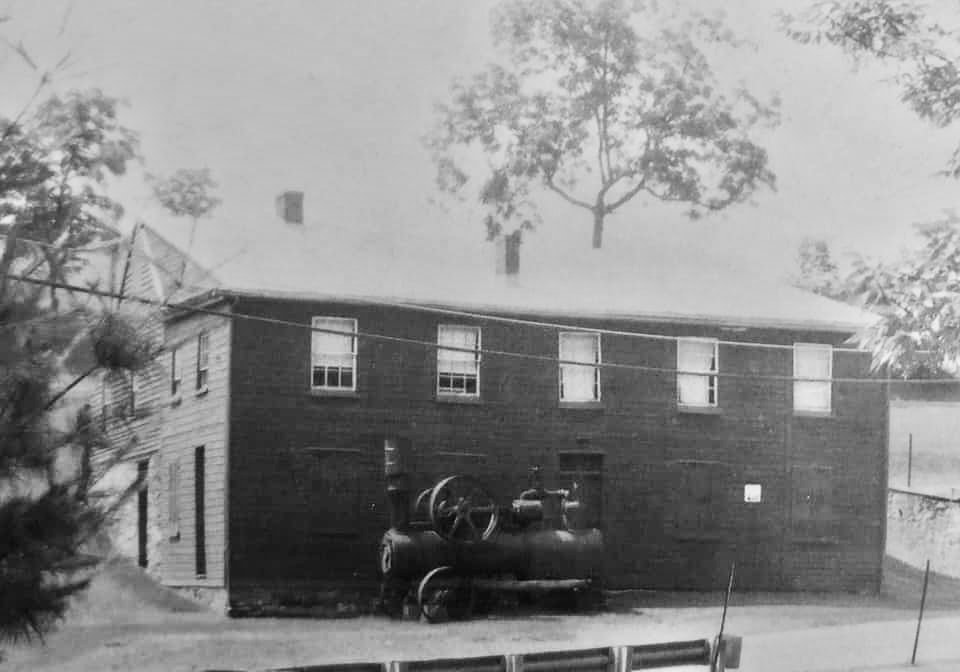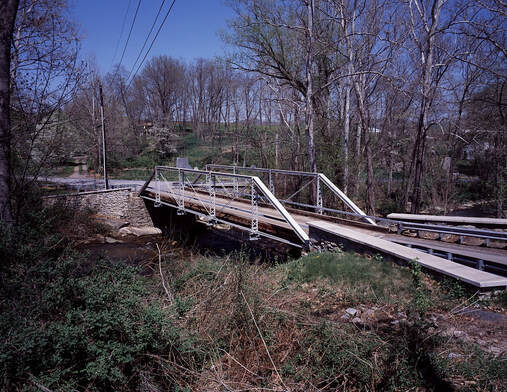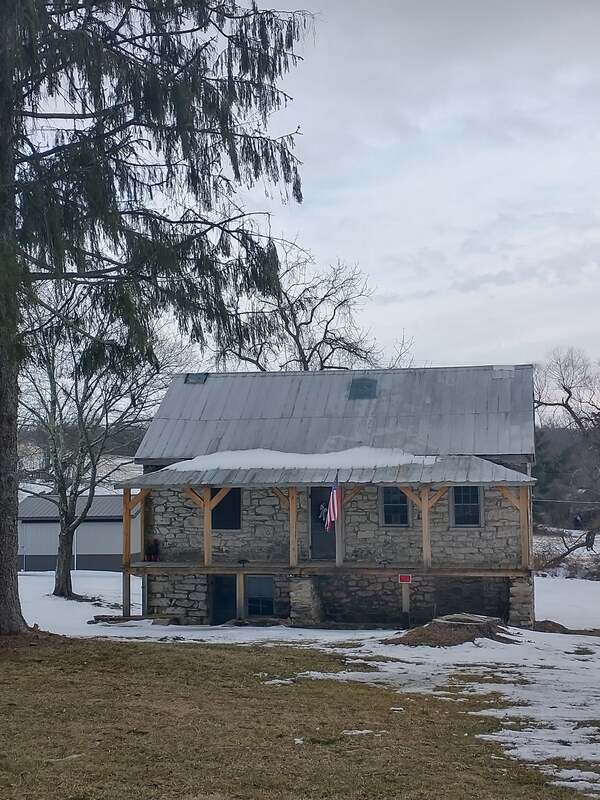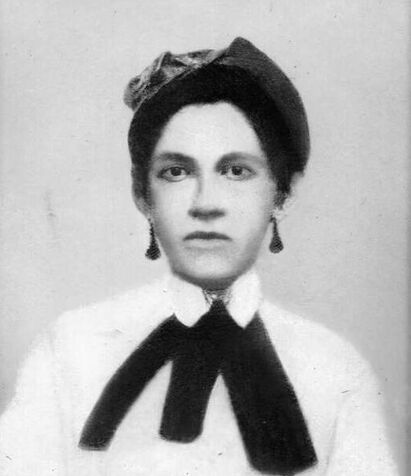Historical Images of Ellerton, Harmony, Jerusalem, Church Hill, Middlepoint, Highland, and Pleasant Walk
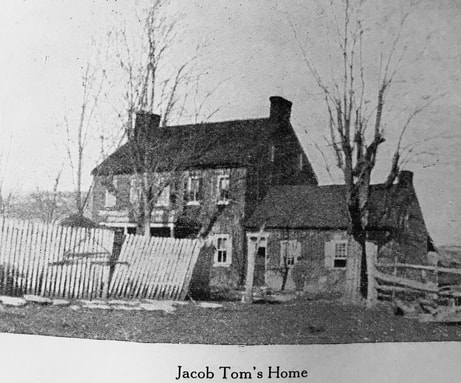
Jacob Tom's' Farm, Jerusalem, Before 1900.
"About one mile and a half northwest of Myersville, Maryland, at the upper end of the beautiful Middletown Valley, a union church was built of logs many years ago.... That old church was widely known as 'Jerusalem Chapel....'
"Jacob Toms lived within a half mile of Jerusalem Chapel.... [his] home, built by him in 1811, was a regular preaching place for [United Brethren] ministers. His son Jacob bought the homeplace.... In this Tom's home Newcomer preached on the 25th of September, 1819, and lodged with Jacob Doub, whose home was nearby,
"In the Toms home, the Board of Trustees of the Benevolent Society of the United Brethren in Christ met April 4, 1828. The following members were present: Valentine Doub, George Marteny, Jacob Doub, Joseph Hershey, and Rev. John Hilt...."
From Landmark History of the United Brethren Church, 1911.
Above: In 1902, Jacob Toms' grandson Claude Evers Toms (1876–1952) purchased the farm from his 73-year-old father, John Henry Toms (1829-1906). Courtesy Jennifer Savaadra.
The Family of Elder George Leatherman of Harmony, Circa 1898. Courtesy Randy Leatherman.
Courtesy Debbie Dutrow.
William Hamilton Leatherman and David Leatherman with their team at Mt. Pleasant Mills, Pennsylvania, Circa 1895. Photo Courtesy Jon Leatherman.
German Church of the Brethren, or Grossnickle's Meeting House, Circa 1895. The congregants posed on a sunny summer day with many of the women wearing fashionable straw boater hats. The meeting house is located at Ellerton.
Grossnickle's Meeting House, Ellerton, Circa 1895.
Calvin, Annie, and Magdalena Kinna Gladhill in Front of Their Home, Harmony, Circa 1895. Calvin Tressler Kinna Gladhill (1874-1935) founded the Gladhill Furniture Company, still in operation in Middletown today. Courtesy John C. Gladhill.
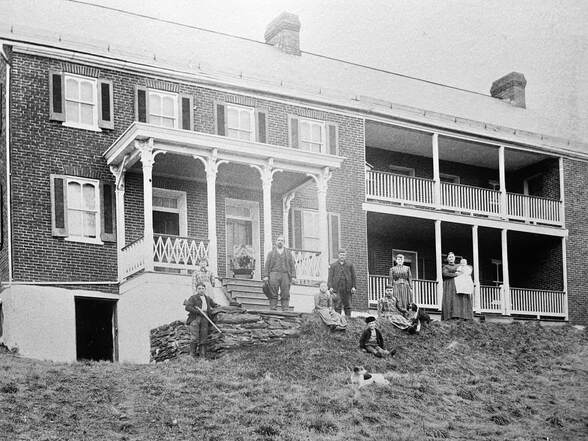
The Tilghman Grossnickle Family Poses in Front of Their Immaculate Farmhouse, Circa 1895.
Left: Forrest School, Circa 1900. Right: Program from Forrest School Reunion, 1995. Courtesy Rod Harne.
Woodland School, Circa 1900.
Wolfsville Band Marching Along Pleasant Walk Road, Circa 1900.
Rice Family Reunion, 1900.
Harmony School, Circa 1900. This school was located across the road from Harmony Lutheran Church. It was later replaced by a wooden school house. Courtesy Carroll Leatherman.
On 3 Nov., 2018, Lorraine McAfee wrote: "Thank you for posting the photograph of the Harmony School. I remember a photograph of the old Harmony School that hung in my grandparents home on the corner of Harmony Road and Brethren Church Road (Charlie Ford's Store). I don't know what happened to it after my grandparents died. I was raised in the house that you see in the upper/right corner of the Harmony School photo. I now know that a barn once stood where the chicken house was when I was a child/young adult. The foundation of the chicken house was stone and large, so it was likely the original foundation of the barn. Mother had the chicken house, hog pen, and outhouse taken down sometime between 1990-2006."
On 3 Nov., 2018, Lorraine McAfee wrote: "Thank you for posting the photograph of the Harmony School. I remember a photograph of the old Harmony School that hung in my grandparents home on the corner of Harmony Road and Brethren Church Road (Charlie Ford's Store). I don't know what happened to it after my grandparents died. I was raised in the house that you see in the upper/right corner of the Harmony School photo. I now know that a barn once stood where the chicken house was when I was a child/young adult. The foundation of the chicken house was stone and large, so it was likely the original foundation of the barn. Mother had the chicken house, hog pen, and outhouse taken down sometime between 1990-2006."
Harmony, Circa 1900. An early photograph of Harmony, looking toward Ford's Store. Courtesy Wisner family.
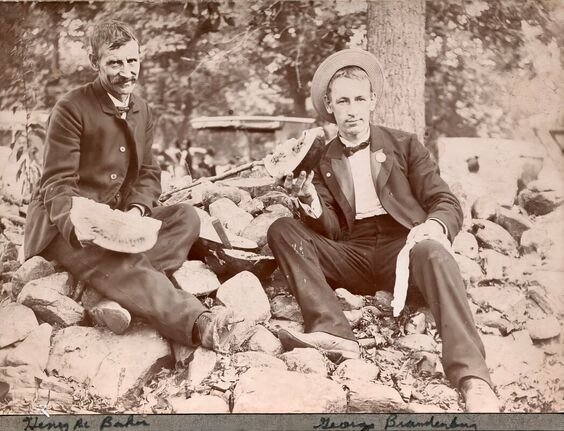
Henry Robert Lee Baker and George Washington Brandenburg eat refreshing watermelon on a sunny summer day in Harmony, about 1900. Courtesy Richard Hartsock.
Mount Bethel Methodist Church, Circa 1905. Located between Wolfsville and Foxville, it was founded in 1836 and was a log structure until this replacement was built in 1902.
Marker Mill, Circa 1905. Also known as Point Rock Mill or Duvall Mill, it was first owned by George Marker between 1815-1827. According to a 1984 Valley Register article by Dr. Harold Moser, "This small mill tucked away among the hills of the Catoctin District survived the competition of many larger mills in the county until the very end of the era of mills powered by water. From 1881 to 1925 this mill was known locally as the Duvall Mill. Its historical uniqueness was recognized at the beginning of the Twentieth Century and a postcard was designed bearing its likeness."
Middlepoint School, Circa 1895. This picture is said to include: John L. Palmer; Norma Gouker; Foster Blickenstaff; Roger Grossnickle; ? Draper; Mary Palmer; Nellie Grossnickle; Lucy Cline Toms; Bruce Palmer; Nettie G.; Stanley Grossnickle; Nettie Harshman; Annie Frushhour Grossnickle; Cora Jackson; Ruth Cline; Effie Palmer; Elmer Delauter?; Grace Gouker; Bickford Lizler; Robert Cline; Mary G. ?; Mary Grossnickle?.
Hawbottom School, Circa 1910.
Pleasant Walk School, 1894. Courtesy Joanne Horine.
Lee Wolfe and Family in front of their home, Circa 1900
Pleasant Walk United Methodist Church, Circa 1902. First called Mount Olive United Brethren Church, the original building was erected in 1867.
George Washington Fisher and Family, Circa 1908. The family were natives and residents of Harmony.
The William Brandenburg Family of Harmony, Circa 1910. Courtesy Steve Murphy.
Ellerton School, Circa 1910. The boy seated on the steps is Elmer Shepley.
Ellerton School, Circa 1910. The roster includes a plethora of local family names, including Routzan, Sheply, Leatherman, Main, Grossnickle, Harshman, Summers, and Gouker. Courtesy Jennifer Ogle Saavedra.
1st Row - Naomi ROUTZAHN, Harold GROSSNICKLE, Madeline STROUP, Millard SUMMERS,
Florence BAKER, Regina GOUKER, Annie ROUTZAHN, Vernon SUMMERS, Hubert DERR,
Edgar CARTER, Clarence MAIN, Harry HARSHMAN, Willie ROUTZAHN
2nd Row - Mary SHEPLEY, Mildred SHEPLEY, Eva GAVER, Pauline SUMMERS, Erma GAVER,
Clara ROUTZAHN, Nellie GROSSNICKLE, Russell SHEPLEY, Ralph GAVER
3rd Row - Orville SHEPLEY, Mary MAIN, Grace BROWN, Pearl HARSHMAN, Sammy ROUTZAHN,
Harry BAKER, Etta SUMMERS, Erma CARTER, Dorothy PRYOR, Ethel BAKER
4th Row - Willie CARTER, Albert BABINGTON, Elmer JOHNSON, Nellie LEATHERMAN,
George GAVER, Elmer LEATHERMAN, Wilbur SUMMERS
1st Row - Naomi ROUTZAHN, Harold GROSSNICKLE, Madeline STROUP, Millard SUMMERS,
Florence BAKER, Regina GOUKER, Annie ROUTZAHN, Vernon SUMMERS, Hubert DERR,
Edgar CARTER, Clarence MAIN, Harry HARSHMAN, Willie ROUTZAHN
2nd Row - Mary SHEPLEY, Mildred SHEPLEY, Eva GAVER, Pauline SUMMERS, Erma GAVER,
Clara ROUTZAHN, Nellie GROSSNICKLE, Russell SHEPLEY, Ralph GAVER
3rd Row - Orville SHEPLEY, Mary MAIN, Grace BROWN, Pearl HARSHMAN, Sammy ROUTZAHN,
Harry BAKER, Etta SUMMERS, Erma CARTER, Dorothy PRYOR, Ethel BAKER
4th Row - Willie CARTER, Albert BABINGTON, Elmer JOHNSON, Nellie LEATHERMAN,
George GAVER, Elmer LEATHERMAN, Wilbur SUMMERS
Black Rock Hotel, Circa 1910-1915. Walter C. Rowe of Myersville took the below photo of the hotel that once stood on South Mountain. Open as early as 1820s, the Black Rock Hotel burned down sometime after 1920. The source for the top photo is Western Maryland Regional Library.
The Hays family of Ellerton in 1910. From left in front: Herbert, Carlotta, and Elizabeth Hays. Seated from left: unknown woman with child; Allen and Lydia Hays (the parents of Milton G. U. Hays); Josephine Farsht Hays. Back row from left: Paul Hays, Milton G.U. Hays, Robert Brumbaugh, and Emma H. Brumbaugh. Photo courtesy Nancy Hendricks.
John and Emma Haller Waters family of Harmony, about 1910. Back row from left: Norbet, Fannie, James, Annie, and Edna Waters. Ruth, in middle in front of James. Front from left: son John Clarence, Mary, and Emma (Haller) Waters. John Waters, father of the family, died in 1902.
Charles Johnson Mill and Home, Ellerton, 1918. Courtesy Maurice Barkley.
Ellerton School in May 1918, taken by the teacher. Photo courtesy Nancy Hendricks.
Local Girls on Top of Eldridge Hill, Circa 1918. Front: Nora Toms, Kathyrn Rebecca Harshman (1906 - 1973); Back: Pearl Keller, Mabel Toms. Courtesy Jennifer Savaadra.
Baker Family Reunion on the Ezra Baker Farm, Harmony, Circa 1920. Courtesy Mary Sprecht.
Fiftieth Anniversary of Mahlon Benjamin Green and Mary Ellen Salina Hoffman Green, Church Hill, July 1922. The couple married 14 July, 1872. Mahlon was born in the upper Middletown Valley near Ellerton on May 21, 1848, a son of Samuel and Sarah Rice Green of Church Hill. Benjamin farmed the same land as his father and maternal grandfather -- 9-1/2 acres called "Shady Grove" on Church Hill and Md. Route 17.
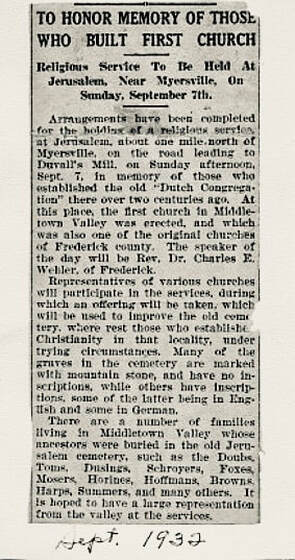
Jerusalem Cemetery, Easterday Road, in the Early to Mid-1900s. The original church sat in the approximate area of the monument at left.
Excerpt from an Address Given by Cyrus Flook, Valley Register, August 15,1932.
"As early as 1774, ten acres of ground were deeded by Philip Rodenspiller to the Dutch Congregation at Jerusalem. The first church served its time; allowing the average time for decay, it must have been built about 1715 as a 'squatter's choice,' and when Rodenspiller came to possession of the grounds, the Dutch people made a purchase, it being only a deed of trust, so this unsectarian congregation disbanded....
"The church was built on the left side of the road leading from Myersville to Pleasant Walk, by way of Jerusalem. The second building was built on the same site. In 1827, a third church was built--a United Brethren Church at Jerusalem. The location was where now stands a monument to mark the site where the church was erected."
The Old Church at Jerusalem, Valley Register, Oct. 19, 1923.
"Rev. H.A. Koogle of Chapman, Kansas, went to Sunday School at the Jerusalem Church in 1853. In a letter to the Register he wrote:
'It was an old church, even then, and I played many times around it during the noon hours of school. There was a day school, Hazel Bottom, nearby.)
'The pulpit in the church was boxed up front and on the right of the speaker. It was heated with a wood stove--a large horizontal drum about eighteen inches sat atop the stove.
'There was a large post to support the ceiling. My class was in the seat by the post. The small children were taught the alphabet and to spell and read, much the same as in day school. The older scholars used a small New Testament. My class used a religious speller which was illustrated.'
'My Sunday School teacher was Jacob Poffenberger, father of Rev. J.W. Poffenberger.
'I attend my first picnic in a grove close to the church, but it was called a celebration then.
'The first funeral I remember was that of a colored man named Lewis Jones. He lived in a one room house a short distance west of the crossroads. He is buried in the Jerusalem cemetery.'"
Excerpt from an Address Given by Cyrus Flook, Valley Register, August 15,1932.
"As early as 1774, ten acres of ground were deeded by Philip Rodenspiller to the Dutch Congregation at Jerusalem. The first church served its time; allowing the average time for decay, it must have been built about 1715 as a 'squatter's choice,' and when Rodenspiller came to possession of the grounds, the Dutch people made a purchase, it being only a deed of trust, so this unsectarian congregation disbanded....
"The church was built on the left side of the road leading from Myersville to Pleasant Walk, by way of Jerusalem. The second building was built on the same site. In 1827, a third church was built--a United Brethren Church at Jerusalem. The location was where now stands a monument to mark the site where the church was erected."
The Old Church at Jerusalem, Valley Register, Oct. 19, 1923.
"Rev. H.A. Koogle of Chapman, Kansas, went to Sunday School at the Jerusalem Church in 1853. In a letter to the Register he wrote:
'It was an old church, even then, and I played many times around it during the noon hours of school. There was a day school, Hazel Bottom, nearby.)
'The pulpit in the church was boxed up front and on the right of the speaker. It was heated with a wood stove--a large horizontal drum about eighteen inches sat atop the stove.
'There was a large post to support the ceiling. My class was in the seat by the post. The small children were taught the alphabet and to spell and read, much the same as in day school. The older scholars used a small New Testament. My class used a religious speller which was illustrated.'
'My Sunday School teacher was Jacob Poffenberger, father of Rev. J.W. Poffenberger.
'I attend my first picnic in a grove close to the church, but it was called a celebration then.
'The first funeral I remember was that of a colored man named Lewis Jones. He lived in a one room house a short distance west of the crossroads. He is buried in the Jerusalem cemetery.'"
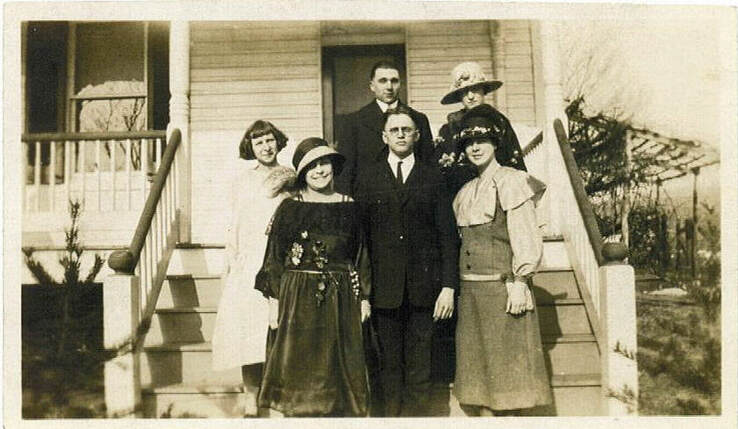
A happy wedding day in Harmony, 21 February, 1923. Top: Groom Carrol Feete Leatherman (1898-1977); Bride Eleanor Hedges (1901-1988). Second row (L to R): Ida Hedges; Harry Hedges; unknown girl. The young girl in back is Miriam Hedges Atwood. Photo Courtesy Jim Pinkston.
Ezra Baker (1831-1932) of Harmony (Second from Left). Here, the future centenarian stands with three generations of his family on the upper porch of their home place, circa 1928. Courtesy Richard Hartsock.
Gaver Family Reunion, Circa 1930. Lewis Franklin Gaver (1866-1944) and Minnie Victoria Schroyer (1872-1934) are seated front row, center.
New Harmony School, Circa 1930. Courtesy Wisner family.
Middlepoint Covered Bridge, Circa 1930. The bridge was built in 1841 and was pulled down in 1933. No one knew it then, but it was a terrible loss to Frederick County's 21st Century history tourism. Locals used the remains for firewood. Left: Courtesy Ashley Grossnickle; Right: Courtesy Draper family.
Harmony Grist Mill. The old grist mill later served as woolens factory, post office, and radio and television repair shop. Left: Courtesy Steve Murphy. Right: Courtesy Wisner family.
Harmony Band, Circa 1900. Photo courtesy Steve Murphy.
Harmony Band, Circa 1935. Band leader Les Brandenburg (1894-1947) is center front.
Harmony Band, circa early 1960s. Photo courtesy Vicki Warrenfeltz Corson.
Harmony Softball Team, August 1941. Front row, L-R: Russel (Bub) Baker, Earl Ropp, Austin Brandenburg, Thurman (Ziggy) Shank, Rudolph Brandenburg. Middle row: Austin Gladhill, Glenn Bidle, Roland Cline, Albert Summers. Top row: Cecil Keller, Eugene Ropp, J. Meredith Ropp, Arthur Cline, Harry Keller, Jr. Photo courtesy Lorraine Ropp McAfee.
A Group of Women Pose at Grossnickle Church of the Brethren, Circa 1950. The reverse reads: First Row: Doris Lewis, David Gaver, Gladys Willard, Mae Early, Anna May Willard, Marilyn Leatherman, Jane Wolfe. 2nd Row: Pattie Delauter, Jane Leatherman, Delores Harshman, Joyce Leatherman, ?, Shirley Bowling, Effie Delauder. 3rd Row: Janet Pryor, Esther Pryor, Grace Grossnickle, Martha Grossnickle, Ruth Ann Lewis, Jane Grossnickle, Kathleen Grossnickle. 4th Row: Dortha Grossnickle, Joann Eccard, Janice Lewis, Joyce Gaver, Donna Faye Cooey.
Gaver Family Reunion, Circa 1945.
Henry Dusing (1883-1954) (Front Left) and His Band of Players, Circa 1950. Henry Dusing was well-known in the Myersville area as a self-taught violinist and state champion violin player. He played mainly for the entertainment of the residents of Pleasant Walk. At age 71, Dusing was fatally injured when he accidentally walked in front of a car atop South Mountain on U.S. 40. The son of Emanuel and Susan Lapole Dusing, he was born in Pleasant Walk and resided almost all his life in that area.
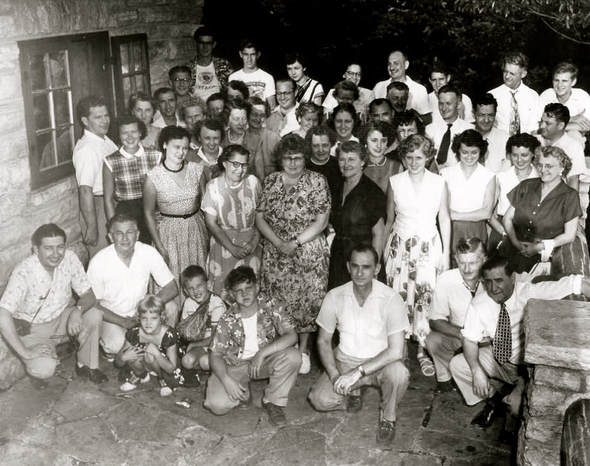
Gaver Family Reunion, 1953.
Grossnickle Reunion, 1957. This gathering took place at Grossnickle's Church of the Brethren, Ellerton.
Ellerton, Circa 1960. Courtesy Pam Detrick.
Ellerton, circa 1965. Ann Longmore-Etheridge Collection.
Summers Store, Ellerton, Circa 1980.
Jerusalem Cemetery, Early 1960s. Courtesy Doug Martin.
Harmony Road Bridge, Myersville, Circa 1968. Built in 1918, Harmony Road Bridge spans Little Catoctin Creek. Metal truss bridges were the most popular bridge form in the county between the 1870s and 1930s, facilitating vehicular movement throughout the developing region. Courtesy Library of Congress.
Harmony Road Near Little Catoctin Creek, Circa 1968. Courtesy Library of Congress.
Metzer Farm, Ellerton, Circa 1970.
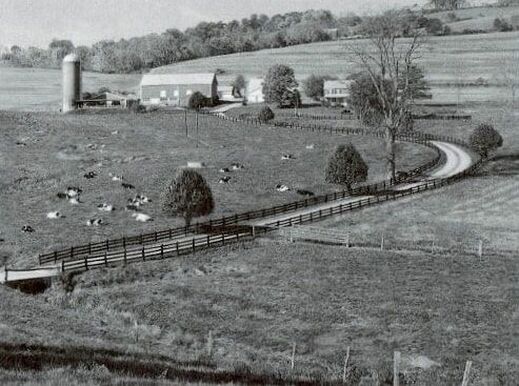
Red Cross First Aid Class Taught by Don Schley (Seated, Right). Church of the Brethren, Ellerton, Autumn 1971. Photo courtesy Donna Grossnickle.
Garnand Homeplace, Circa 1980. This house was built by members of the Swiss immigrant Garnand family in the mid-1700s. It was completely restored by Don Easterday and sits on the Ostertag Vistas property near Pleasant Walk.
The Doub-Routzahn Farmhouse, 1992. The farm on Church Hill Road was the home of Myersville Bank President Ezra Routzahn and his wife Sarah Catherine Harp from 1870 until Routzahn's death in October 1915. Afterward, it passed to his son Franklin. The Maryland Historical Trust noted, "The Doub-Routzahn Farmstead exemplifies the transition of a mid-19th-Century farmstead from agricultural to private residential use in the mid-20th Century. It retains features from its possible establishment as a typical farm of the period of about 1840-1870 in the brick dwelling with domestic outbuildings and the frame and stone bank barn, with the additions of late 19th century outbuildings which reflect changes in agricultural technology such as the wagon shed/com crib, the garage, and the proliferation of various sheds in the agricultural grouping…. Architecturally, the farmstead is a fair example of the vernacular architectural style in the period 1840-1940.”
St. John's Lutheran Church, Church Hill, 1992. Built in 1830 to replace an earlier log structure, according to geneaologist Bob Fout, "The interior was just one large room, with wrap-around galleries on three sides. In keeping with German tradition, the sanctuary was designed with two front doors, one for gentlemen and one for ladies. In the beginning, the church had no bell tower. Then in 1895, carpenters constructed a belfry. A 700-pound church bell was cast in Cincinnati at a cost of over $200.00. Money was raised by donations from church members and public solicitation. Its melodious strains would call neighbors to worship each Sunday. It would also ring to alarm for fires and other emergencies. At the time of a death in the community, the tolling mechanism would count out the age of the deceased."
Church Hill School, Church Hill, 1992. The school was built in 1912. To read a complete survey of the Church Hill area undertaken in the 1990s, click here.
Daniel Palmer House, Ellerton, 1992. The Daniel Palmer Farmstead was originally an agricultural complex, now a private residence, that was built about 1820 and is centered on a two-story brick dwelling with a three-bay north elevation and a rebuilt entry porch. Accompanying the house is a contemporary log or frame and stone summer kitchen and springhouse with german siding and an exterior brick and stone chimney, a circa 1850 brick bake oven and smokehouse combination, and a frame privy.
Highland School, Highland School Road, Near Myersville, March 1992. The Highland School is a one-story brick schoolhouse that was built 1852 and which was converted to residential use in 1942.
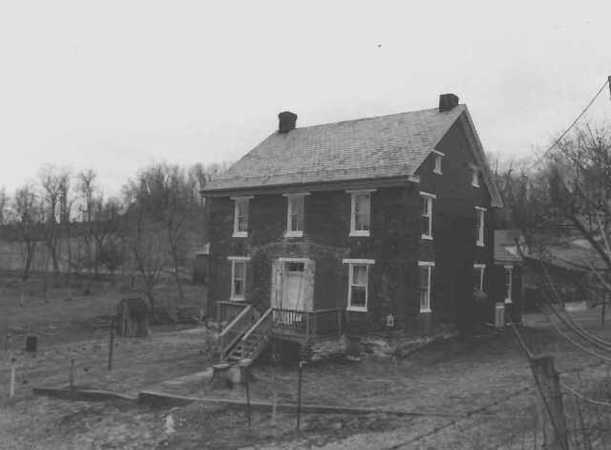
St. John's Lutheran Church Parsonage, Church Hill, 1992. The former parsonage is located at 3251 Ward Kline Road, and part of the Church Hill Survey District.
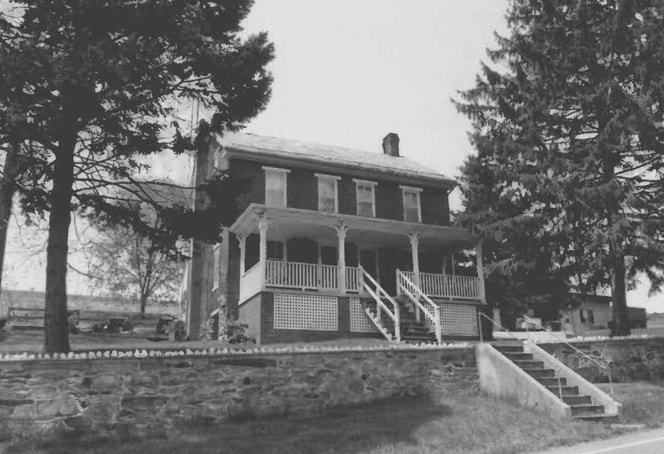
10708 Harp Hill Road, Ellerton, 1992.
Crow Rock Road Bridge, Ellerton, 1997. Courtesy Library of Congress.
The Schroyer Home, Pleasant Walk, Under Restoration, 2022. Right: Amanda M. Schroyer Eccard (1853-1928) was raised in this house. Courtesy Sharon Lina Pierce.
